Abstract
We examined the possibility that the peroxidative damage to central nervous system myelin produced by reactive oxygen species (ROS), could modify the susceptibility of its proteins to the proteolytic action of proteases such as trypsin and subtilisin. Purified myelin membranes obtained from adult rat brains were “in vitro” peroxidized by two non-enzymatic systems: Fe3+ plus ascorbic acid and Cu2+ plus hydrogen peroxide. Myelin proteins were severely affected by peroxidation. There was an increase in the amount of carbonyl groups (CO), accompanied by and enhanced susceptibility to degradation by trypsin and subtilisin of myelin basic proteins (MBP) and of the major proteolipid protein (PLP). The effect upon the degradation of myelin protein is a possible consequence of the appearance in the structure of myelin proteins of peroxidative modifications that contribute to the recognition by proteolytic enzymes. This hypothesis is supported by the fact that if peroxidation of myelin membranes is done in the presence of EDTA, both CO formation and increased sensitivity to enzymatic breakdown disappear. These results suggest that the appearance of abnormal post-translational modifications in the myelin membrane produced by peroxidation could constitute a putative mechanism of modulating the capacity of myelin proteins to be metabolized by proteases.
Similar content being viewed by others
References
Banik, N. L., Chakrabarti, A. K., and Hogan, E. L. 1987. Distribution of calcium activated neutral proteinase (mM CANP) in purified myelin and cytosolic fractions of bovine brain white matter. Life Sci. 41:1089–1093.
Banik, N. L., Gohil, K., and Davison, A. N. 1976. The action of snake venom, phospholipase A and trypsin on purified myelin in vitro. Biochem. J. 159:273–276.
Banik, N. L., McAlhaney, W. W., and Hogan, E. L. 1985. Calcium stimulated proteolysis in myelin: evidence for a Ca2+ activated neutral proteinase associated with purified myelin of rat CNS. J. Neurochem. 45:581–585.
Benedetti, A., Compori, M., and Esterbauer, H. 1980. Identification of 4-hydroxynonenal as cytotoxic product originating from the peroxidation of liver microsomal lipids. Biochim. Biophys. Acta 620:281–296.
Berlet, H. H., Ilzenhofer, H., and Schulz, G. 1984. Cleavage of myelin basic protein by neutral protease activity of human white matter myelin. J. Neurochem. 43:627–632.
Bongarzone, E. R., Pasquini, J. M., and Soto, E. F. 1994. Oxidative damage to proteins and lipids of CNS myelin produced by in vitro generated reactive oxygen species. J. Neurosc. Res. in press.
Chantry, A. C., Earl, C., Groome, N., and Glynn, P. 1988. Metalloendoprotease cleavage of 18.2 and 14.1 kilodalton basic proteins dissociating from rodent myelin membranes generates 10.0 and 5.9 kilodalton C-terminal fragments. J. Neurochem. 5:688–692.
Connor, J. R., and Fine, R. E. 1987. Development of transferrin-positive oligodendrocytes in the rat central nervous system. J. Neurosc. Res. 17:51–59.
Connor, J. R., Menzies, S. L., St Martin, S. M., and Mufson, E. J. 1990. Cellular distribution of transferrin, ferritin and iron in normal and aged human brains. J. Neurosci. Res. 27:595–611.
Davies, K. J. A. 1987. Protein damage and degradation by oxygen radicals I. General aspects. J. Biol. Chem. 262:9895–9901.
Davies, K. J. A., and Goldberg, A. L. 1987. Proteins damaged by oxygen radicals are rapidly degraded in extracts od red blood cells. J. Biol. Chem. 262:8227–8234.
Fucci, L., Oliver, C. N., Coon, M. J., and Stadtman, E. R. 1983. Inactivation of key metabolic enzymes by mixed function oxidation reactions: Possible implication in protein turnover and ageing. Proc. Natl. Acad. Sci. USA. 80:1521–1525.
Gerber, M. R., and Connor, J. R. 1989. Do oligodendrocytes mediate iron regulation in the human brain? Neurol. 26:95–98.
Halliwell, B., and Gutteridge, J. M. C. 1989. Free radicals in Biology and Medicine. Clarendon press, Oxford.
Laemmli, U. K. 1970. Cleavage of structural proteins during the assembly of the head of bacteriophage T4. Nature 227:680–685.
Levine, R. L. 1989. Proteolysis induced by metal catalyzed oxidation. Cell Biol. Rev. 21:347–360.
Levine, R. L. 1983. Oxidative modification of glutammine synthase II. Characterization of the ascorbate model system. J. Biol. Chem. 258:11828–11833.
Lowry, O. H., Rosebrough N. J., Farr, A. L., and Randall, R. J. 1951. Protein measurement with the Folin phenol reagent. J. Biol. Chem. 250:1099–1105.
Murphy, M. E., and Kehrer, J. P. 1989. Oxidation state of tissue thiol groups and content of protein carbonyl groups in chickens with inherited muscular dystrophy. Biochem. J. 260:359–364.
Mickel, H. S. 1985. Biological effects of lipid peroxides: lipid peroxidation hypothesis of the etiology of Multiple Sclerosis. The pharmacological effect of lipids II, 215–246.
Norton, W. T., and Poduslo, S. E. 1973. Myelination in rat brain: method of myelin isolation. J. Neurochem. 21:749–757.
Ohkawa, H., Ohishi, N., and Yagi, K. 1979. Assay for lipid peroxides in animal tissues by thiobarbituric acid reaction. Analyt. Biochem. 95:351–358.
Schaich, K. M. 1992. Metals and lipid oxidation. Contemporary issues. Lipids 27:209–218.
Stadman, E. R. 1990. Metal ion catalyzed oxidation of proteins: biochemical mechanism and biological consequences. Free rad. Biol. Med. 9:315–325.
Stadman, E. R. 1990. Covalent modification reactions are marking steps in protein turnover. Biochem. 29:6323–6331.
Stadman, E. R. 1992. Protein oxidation and aging. Science 257: 1220–1224.
Toshiwal, P. K., and Zarling, E. J. 1992. Evidence for increased lipid peroxidation in multiple sclerosis. Neurochem. Res. 17:205–207.
Whitaker, J. N. 1987. The presence of immunoreactive myelin basic protein peptide in urine of persons with multiple sclerosis. Ann. Neurol. 22:648–655.
Wolff, S. P., and Dean, R. T. 1988. Aldehydes and dicarbonyls in nonenzymic glycosylation of proteins. A rebuttal to Harding and Beswick. Biochem. J. 249:618–619.
Wood, J. G., Dawson, R. M. C., and Hauser, H. 1974. Effect of proteolytic attack on the structure of CNS myelin membrane. J. Neurochem. 22:637–642.
Author information
Authors and Affiliations
Rights and permissions
About this article
Cite this article
Bongarzone, E.R., Soto, E.F. & Pasquini, J.M. Increased susceptibility to degradation by trypsin and subtilisin of in vitro peroxidized myelin proteins. Neurochem Res 20, 421–426 (1995). https://doi.org/10.1007/BF00973097
Accepted:
Issue Date:
DOI: https://doi.org/10.1007/BF00973097



